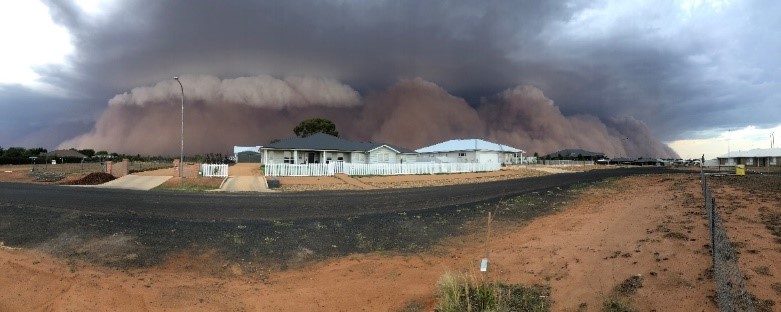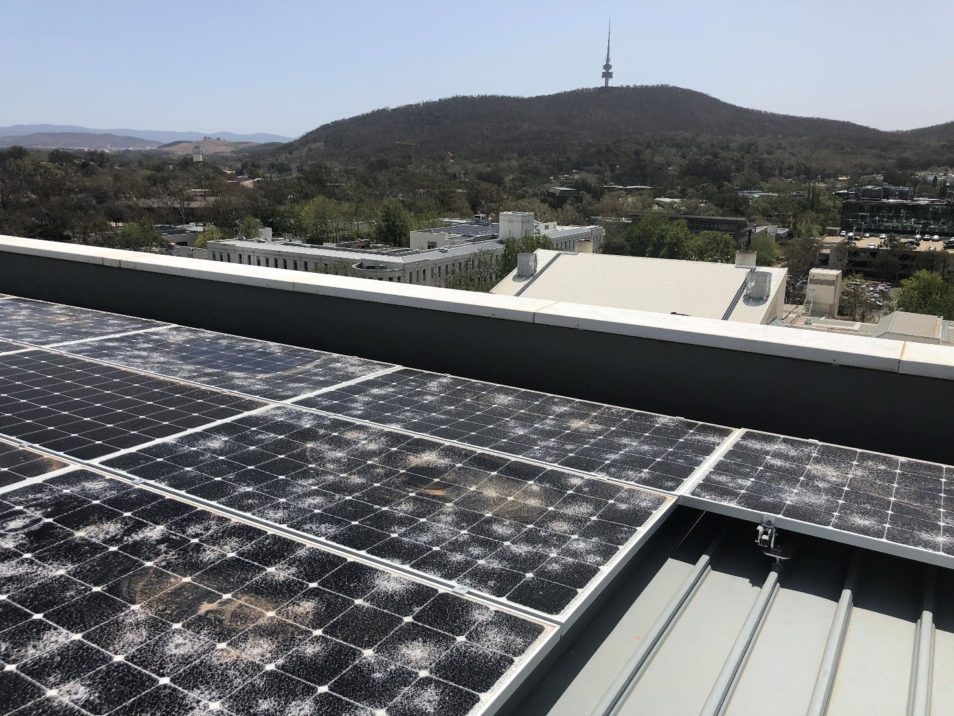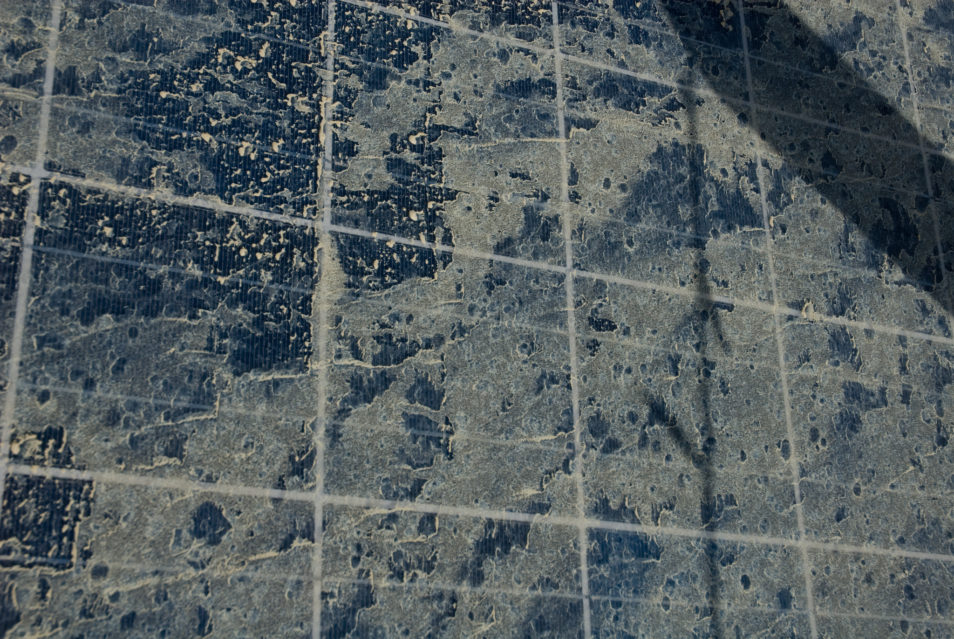
ABC reporter Jen Browning faces the impending dust storm in rural NSW. Image: Jen Browning.
This summer, bushfire smoke has blanketed towns and cities across Australia. Dust storms descended on western New South Wales with clouds “so thick they blocked out the sun!” In Canberra, hailstorms battered cars, houses, greenhouses and solar panels.
So, how do hailstorms, dust storms and smoke affect your solar panel performance? What happens to solar power when you can’t even see the sun? We spoke to our head of Solar Technologies, Dr Greg Wilson, to get some answers.
What happens to solar panel performance when there’s smoke and dust in the air?
“Solar panels take in sunlight and material on the panels’ surface converts sunlight to electrons, which become electricity,” Greg explains.
“Anything that blocks out the sun will reduce the amount of energy your panels produce.”
Bushfire smoke and dust storms can cause elevated particle levels in the atmosphere. Smoke from bushfires is made up of gases, water vapour and particles. These particles are so tiny they’re not visible to the naked eye. The NSW Health Department and EPA estimates some particles are <2.5 micron. That’s about three per cent the diameter of a human hair.
What happens to photovoltaic (PV) capacity on hazy or dusty days?
“It really depends where you are. At our Energy Centre in Newcastle, with an ocean breeze, we still saw significant loss in energy production on hazy days. Our solar panels were down 10 to 30 per cent compared to last year,” Greg says.
“Yet at my home 20 kilometres away, with no ocean breeze, I had 80 per cent reduction in energy output.”
Indeed, solar monitoring company Solar Analytics found rooftop PV systems in Sydney and Canberra plummeted by 15 to 45 per cent on smoky days this summer.

A dust storm hit Dubbo on 20 January 2020. It deposited fine dust reducing electrical output. Image: Andrew Hildebrandt
Does ash from bushfires affect solar panel performance?
“Unless you’re close to fires where embers are falling, ash is just a different type of dust,” Greg says. “Solar panels are not self-cleaning, but debris will wash off when it rains.”
How do hailstorms affect solar panels?
The January hailstorm in Canberra damaged houses, cars and solar panels across the city. This included our Black Mountain Science and Innovation Park. Thankfully no-one was injured, but 65 glasshouses and several solar panels were destroyed.
Solar panels are rated using two class systems. There’s a ‘Severe Hail Damage Resistance Test’, which tests panels for cricket ball-sized hailstones. Most panels are tested according to the ‘Moderate Hail Damage Test’, comprising 25mm hailstones that weigh 7.53 grams.
The hailstones that hit Canberra, in January 2020, were golf ball-sized weighing about 20 grams each. That’s larger than normal conditions for ‘Moderate Hail’ and outside the normal testing parameters for PV panels. As this weather becomes more frequent with climate change, rating systems will need to reflect extreme events. This means we need to improve design of our panels to withstand such conditions.

Hail damage to solar panels in Canberra after the January 2020 hailstorm. Image: Capital solar maintenance.
Should I clean my panels after an extreme weather event?
First of all, work with your installer to ensure your solar system is positioned away from overhanging trees. You’re less likely to encounter bird droppings, sap, power losses due to shading, or an environment where lichen or mould could grow.
For most homes in Australia, rainfall will be enough to keep the solar panels relatively free of debris, meaning there’s no need to have them cleaned. One exception may be in extreme drought conditions, although then you may be under water restrictions anyway.
If you do want to clean your solar system, we recommend consulting a professional (start with your installer), to avoid the risk of personal injury due to falling from the ladder or roof. Falls from ladders are a leading cause of serious injury to people on their properties.
If you insist on doing it yourself, detergent shouldn’t be necessary. Use plain water from a hose or bucket, and a soft brush or mop on a long handle. Patches of lichen or bird droppings can be pre-soaked for easy removal with a scraping tool. Avoid high-pressure cleaners, which can force water inside the panel and will likely void your warranty.

A build-up of dirt and grime can significantly reduce the efficiency of your solar panels. Image: Jesse Wagstaff
A build-up of dirt and grime can significantly reduce the efficiency of your solar panels. Image: Jesse Wagstaff
Be careful of solar panels after an extreme weather event
Greg warns people to be extremely careful when returning to their house after extreme weather events. While the sun is out, your solar PV system will continue generating electricity.
Even with network supply turned off, treat the system and wires as if they are live. If wires have come loose and are touching the roof, it is electrified. Also, if your panels are damaged, you could receive a lethal electric shock turning the system back on.
“Get a licenced electrician or an accredited installer to check that your system is safe. Isolate the PV system electrically before returning to your house,” Greg says.
“Tragically, there are reports of emergency services personnel seriously injured where solar panels are still electrified.”
More information
For more information on how to prepare your house and solar panels before a natural disaster, see these articles by the NSW Government and Clean Energy Council. For information on returning to your house after a natural disaster, read these articles by the Australian Red Cross, Victorian Government, and NSW Government. You can also contact your local emergency services for further advice.


19th June 2021 at 4:37 pm
Very nice and informative information about on solar panel performance. Thanks for sharing.
26th July 2020 at 2:54 pm
Way back in the 1960’s, CSIRO Div of Mechanical Engineering designed and built solar hot water heaters. In 1984 I had the opportunity to have one of these solar water heaters tested. It was rebuilt and tested again as before according to AS 2535. The results are given by D. Proctor & T.D. Czarnecki, “The Effect of Aging on a 22 year old Solar Water Heater”, SOLAR ENERGY vol35 p175 1985. The results are rather surprising. Dust on the cover does not appear to have diminished its performance even although it is collecting less solar energy, its heat losses are likewise reduced because the cover is now running much warmer.
Snow does not appear to affect Solar Water or Air Heaters. 100mm layer of snow is quite quickly made to slide off the cover as soon as the sun come up.
25th March 2020 at 1:30 am
Best quality solar panel manufacturer , Canadian solar panel in Pakistan . This is good information. Please keep sharing. Best of luck.
19th March 2020 at 6:29 pm
Is there any data on non-obvious damage to PV panels from hail such as micro-cracking that might worsen over time after the initial hail event?
22nd April 2020 at 4:41 pm
Hi Peter,
We reached out to Dr Chris Fell, Principal Research Scientist (PV Performance Laboratory) to get a response for you. Here’s what he had to say “At least one of the solar system equipment providers claims that this can happen, and some products include panel-level monitoring that may assist in identifying it if it does. I haven’t seen any independently verified data, but I think it is possible. Perhaps unlikely, since the main cause of cell microcracking is localised bending of the panels (e.g. walking on them). But I can’t rule out that the small vibrations caused by hail hitting the glass could possibly crack the cells, particularly around stress points such as solder joints.”
Hope this helps!
Georgia
Team CSIRO
19th March 2020 at 5:55 pm
If the weather forecast includes the possibility of hail or other extreme condition, should we turn the system off?
22nd April 2020 at 4:43 pm
Hi David,
Thanks for your comment. We reached out to Dr Chris Fell, Principal Research Scientist (PV Performance Laboratory) to get a response for you: “Turning the system off of course won’t prevent the mechanical damage that hailstones can cause. But I think your question is about having a damaged, live, system exposed to rain. I’m sure a cracked panel will be further damaged by water, whereas an undamaged panel will not, however that cracked panel needs to be discarded anyway. Will there be an increased risk of fire due to a short-circuit – yes. So you should certainly aim to inspect your PV system after heavy hail. But would I shut my system down when there’s a hail warning – no. My feeling is that hail warnings are quite frequent and only rarely result in actual hail at damaging levels.”
Hope this helps,
Georgia
Team CSIRO